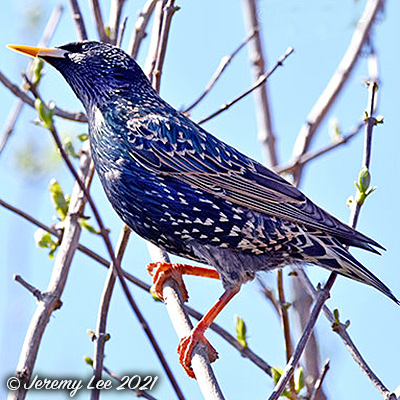
 |
|
Scientific Classifications explained » Amphibians » Ants » Aphids » Bees » Beetles » Birds » Bugs » Butterflies » Caterpillars » Damselflies » Dragonflies » Earwigs » Flies » Frog/Leafhoppers » Fungi » Galls » Grasshoppers » Harvestmen » Hoverflies » Lacewings » Ladybirds » Leaf Mines » Lichens » Mammals » Millipedes » Mosses » Moths » Sawflies » Slugs » Snails » Spiders » Trees & Shrubs » Wasps » Wild Flowers » Woodlice » Postboxes |
UK Nature > Birds > Sturnus vulgaris

Scientific Name: Sturnus vulgaris Common Name: Starling Sturnus vulgaris,, more commonly known as the Starling, is essentially black with purplish and green iridescence and pale, almost white spots covering the plumage, these being most obvious in winter months. The bill is yellow in summer, brown in winter. Their wings look very triangular in flight. Young birds are light brown and are sometimes confused with female blackbirds.They are omnivorous, taking many insects and other invertebrates as well as fruit. A regular at any bird table, often arriving in numbers and frightening other birds away. Their nest is an untidy cup of stalks and leaves, lined with moss and feathers and usually built in holes in trees or buildings or in dense creepers such as ivy. Seen commonly in parks and gardens. Huge numbers can gather together in noisy roosts in winter, often on town buildings. Widespread throughout the UK, although has been in decline in recent years. |
|

https://www.uknature.co.uk is a website dedicated to showing the immense diversity of UK nature and wildlife. Our vast range of habitats, from lowland arable to snow covered mountains, from storm-ravaged coastlines to peaceful inland freshwater lakes and rivers, from dry, sandy heaths to deciduous and coniferous forests, all these habitats contribute to the abundance of UK nature. We have wild birds in huge numbers either residing or visiting our shores (597 recorded species as at July 2013) and we must also not forget the humble back garden with its grass lawns, flower beds filled with nectar rich flowers, shrubs and trees, all designed to attract huge numbers of insects such as bees, moths, butterflies and hoverflies; and finally the small ponds which provide safe havens for frogs, toads, newts and even slow worms and grass snakes. www.uknature.co.uk is the showcase for my personal passion, photographing uknature in all its glory. I sincerely hope you all enjoy the fruits of my labours. This site and all images contained therein is © Jeremy Lee 2004 - 2025. All Rights Reserved. Site design by Jeremy Lee. Site development & IT Support by Stuart Lee. |